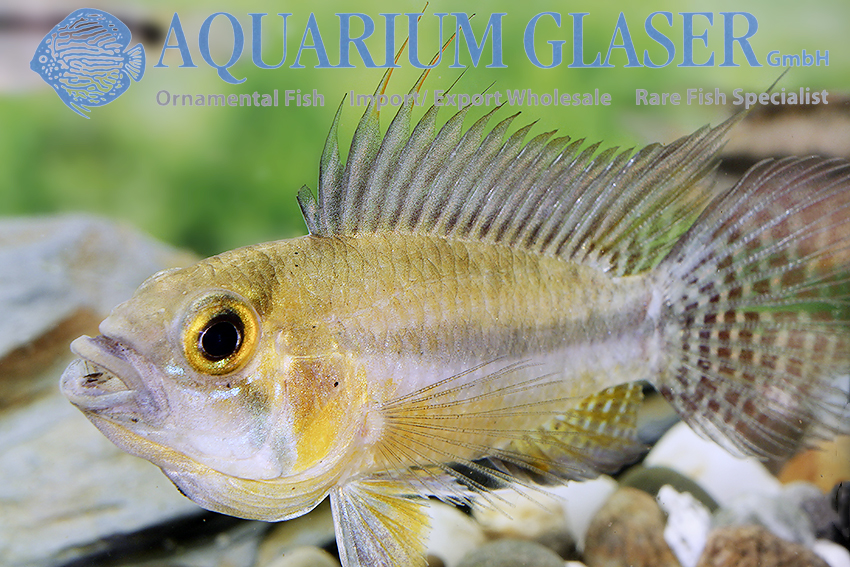yinshutong
Member
- Messages
- 16
- Location
- 中国辽宁省大连市
I do indeed think it's at least an A. cf. cacatuoides.I do not believe that is a cockatoo.

Well if that is truely cockatoo; not only do i stand corrected but it is much nicer than the domestic forms.I do indeed think it's at least an A. cf. cacatuoides.
And there's your reason I say the domestic fish have nothing in common with the original fish. As you rarely see any wild ones anymore I'm a bit hesitant about the orange parts in the fins. Maybe there is some interbreeding with domestic fish, maybe not. Some wild specimens have it, some not.
Here you can see, that in full display the stripes on the stomach disappear and the fish is not as bulky as a whole.

Apistogramma cacatuoides Yellow wild - Aquarium Glaser GmbH
The Cockatoo Dwarf Cichlid is one of the most popular members of the genus Apistogramma and found in petshops all over the World. Almost exclusively bred specimens of very colourful sports are traded. These do not appear in the wild. However, “the” wild form of A. cacatuoides does not exist at...www.aquariumglaser.de
I agree fully.ot only do i stand corrected but it is much nicer than the domestic forms.
It was more the body shape than colour that caught me off guard; I'm used to cockatoo being more like yours or honglsoi - large bodied...I once had some wild ones, (all males unfortunately). I have since seen some domestic ones and they look nowhere near as attractive. I guess in the wild there are several colour variations though.
View attachment 13121View attachment 13122
I once had some wild ones, (all males unfortunately). I have since seen some domestic ones and they look nowhere near as attractive. I guess in the wild there are several colour variations though.
View attachment 13121View attachment 13122
https://fanyi.baidu.com/###I once had some wild ones, (all males unfortunately). I have since seen some domestic ones and they look nowhere near as attractive. I guess in the wild there are several colour variations though.
View attachment 13121View attachment 13122
当我得到它时,商人将其作为另一个品种出售Apistogramma resticulosa!!但我知道不是,功能不是很明显。它可能是在巴西的另一个流域发现的,腹部没有黑点。这是一种非常美丽的鱼,我喜欢它的蓝色我确实认为它至少是一个A. cf. cacatuoides。
这就是你说家鱼与原始鱼没有任何共同之处的原因。由于你很少再看到任何野生的,我对鳍中的橙色部分有点犹豫。也许与家养鱼有一些杂交,也许没有。有些野生标本有,有些没有。
在这里你可以看到,在完全展示的情况下,肚子上的条纹消失了,鱼没有整体那么笨重。
https://www.aquariumglaser.de/en/fish-archives/apistogramma-cacatuoides-yellow-wild-2/
I agree it is quite nice; pity no females or catch location. The first fish in this thread is very interesting. It is the body shape that catches me as much as the colouring. Really don't like domestic cockatoo but some of these wc ones are making me more interested in the species.This is what google translate comes up with:
My fish is of the same species as yours.
When I got it, the merchant was selling it as another variety, Apistogramma resticulosa! ! But I know no, the function is not obvious. It may have been found in another watershed in Brazil without the black spot on the belly. This is a very beautiful fish and I like its blue color
short snapper enthusiast
No mylisz sieTo na 100% Apistogramma cacatuoides jednak jakaś forma cf.Cóż, jeśli to rzeczywiście kakadu, to nie dość, że muszę się mylić, to jeszcze jest o wiele ładniejszy od formy domowej.
No mylisz się. To na 100% Apistogramma cacatuoides jednak jakaś forma por.
No wg Mike Wisa jest ok 20 form cf. cacatuoides w różnych lokalizacjach Peru, Brazylii a nawet ColumbiiMają dość duże zróżnicowanie. Chyba najwyższy czas rozłożyć ten kompleks gatunkowy na czynniki pierwsze.